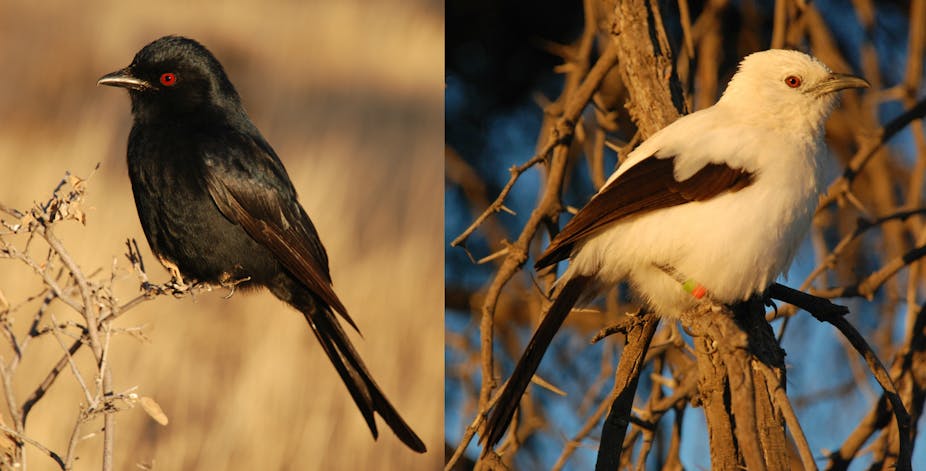In Aesop’s fable of the boy who cried wolf, the boy warns farmers of imaginary wolves threatening their flocks just to laugh at the sight of them running to the rescue for no reason. Of course, when the real wolf comes no one believes his cries – the moral of the story being that nobody believes a liar, even when he tells the truth.
There are some species in nature that also cry wolf, but they are much more clever about it than the boy in the fable. A new study published in the journal Science has shown how a species of African birds called fork-tailed drongos will cry wolf in a bid to steal a free lunch from those they alarm. They wait for an unsuspecting pied babbler or meerkat to find an especially tasty morsel such as a lizard or cricket. Then the drongo screams blue murder and, as the terrified animal runs for cover, swoops in and nabs the abandoned meal.
This system relies on the fact that drongos also sound the alarm when predators actually are present. In fact they act as sentinels, perching high up in the trees and scanning for danger – predators such as foxes, mongooses, and especially raptors such as goshawks – and will quickly call an alarm before diving for cover themselves. Meerkats and other birds, such as babblers and starlings, also produce alarm calls, and since they share many predators each pays attention to the warnings given by the other.
Cross-species alarm calls use is actually quite common in the avian world because a bird that eavesdrops on others’ alarm calls could gain critical, potentially life saving information about predators. For example, members of a species I’ve worked on in North America, called chickadees, are adept at spotting danger and more than 50 different species of birds are known to respond to their alarms. Australian fairy-wrens and scrub-wrens also respond to each other’s alarm calls, and recent work has demonstrated that this interspecies understanding is learned.
This type of cross-species, or heterospecific, eavesdropping is not restricted to birds either. Several types of monkeys eavesdrop on each other’s alarm calls and birds called hornbills can also distinguish between primate alarm calls. Even some species of lizard – which don’t vocalize at all – can understand alarm calls relevant to them.
Predators have, naturally, dramatic impacts on their prey, and it should not be a surprise that animals will use whatever means possible to avoid becoming something else’s lunch.
So, while alarm calling is common, the deceptive use of alarm calls to trick eavesdroppers is much rarer. This type of behaviour was originally proposed for mixed species bird flocks in the Amazon, but fork-tailed drongos are probably the best example. But how do they avoid the fate of the boy who cried wolf in the fable, with other species becoming wise to their false alarms? Drongos have another trick up their sleeves: they pretend to be those other species.

Watching how humans or animals react to repeated stimuli is a commonly used psychological test to ascertain whether a response is habitual or whether the response is connected in some way to the context or source of the stimuli. The boy in the fable crying wolf is eventually ignored, but a cry from someone other than the boy would generate a response, because it is the source of the cry (the boy) that is relevant, rather than the cry itself. The same principle appears in groups of animals; a drongo giving repeated false alarms might soon be ignored were it not for the fact that, as a look-out, the drongo also provides warning of real threats. By mimicking the alarm calls of other species the drongo appears even more reliable.
What the researchers behind this study observed is that drongos adjust their calling behaviour depending on their audience. They are more likely to mimic the species they are targeting – if it’s a babbler they wish to steal from they produce an imitation of the babbler’s alarm, if it is a starling, they imitate the starling.

Drongos were more than twice as likely to mimic a target species’ alarm call during attempts to steal a free meal than that of other species, and when the researchers played back these mimiced calls they found babblers responded more strongly to a drongo mimicking them than to the drongo’s own alarm calls. This suggests that drongos associate each of the mimicked calls with a particular species, rather than simply treating their entire repertoire of alarm calls as the same and interchangeable.
The cunning drongo even goes one step further in this charade, keeping track of whether they have previously fooled certain individual babblers, and varying their alarm calls when attempting to fool and steal from the same individual. The researchers played back alarm calls to babblers and demonstrated that birds become habituated to false alarms, but will respond again if the type of alarm call is changed. Drongos that change their call were much more successful at getting a meal: the likelihood of stealing food from an unsuspecting babbler increased by nearly 50% compared with individuals that did not change their alarm call.
Taken together, this suggests these birds might understand the experience of babblers, indicative of sophisticated cognitive abilities; a very clever bird indeed.

